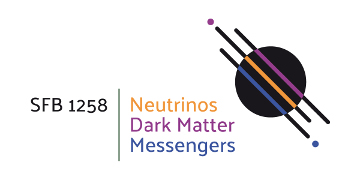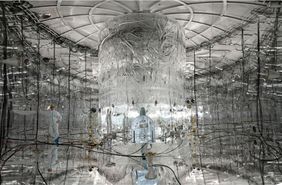The reported lower limit for the 0νββhalf-life of 1.8x1026yr coincides with the expected value for the sensitivity of the experiment; a more stringent value for the decay of any 0νββ isotope has been measured never before. Similarly, the reported background rate of 5.2x10-4 counts/(kg∙yr∙keV) in the signal region is second to none in the field, demonstrating not only the feasibility of a background-free experiment at high exposure but also providing the foundation for a next generation experiment with significantly higher sensitivity.
Searching for physics beyond the standard model
The hypothetical 0νββ decay is a process beyond the Standard Model of Particle Physics: two neutrons within a nucleus, here 76Ge, transform simultaneously into two protons and two electrons ('beta particles') without the common emission of two anti-neutrinos. Its detection would have profound implication for particle physics and cosmology: establishment of Lepton Number Violation and the Majorana nature of neutrinos, i.e. the identity of neutrinos and anti-neutrinos, access to the neutrino mass scale and an important clue for understanding why there is so much more matter than anti-matter in the Universe.
First experiments started 50 years ago
A little more than 50 years ago, Lepton Number Violation had been, indeed, already the issue of the first 0νββ decay search with a 0.1 kg Ge detector chosen by a Milano group because of its outstanding intrinsic energy resolution. Since then, the sensitivity has been increased by a factor of one million. Essential to this track record was the continuous increase of the mass of the detector which simultaneously is the source of the decay, accompanied by the incessant reduction of the background in the signal region: in particular, by running the experiments deep-underground for reducing the background from cosmic rays, and by increasing the 76Ge isotope fraction from 7.8% in the natural Ge detectors via enrichment up to almost 90%.
Sensitivity improvement of a factor of one million
The GERDA experiment has been operated since 2011 at the Laboratori Nazionali del Gran Sasso of INFN, Italy, below a rock over-burden of 3500 m water equivalent. In its final phase GERDA deployed 41 germanium detectors with a total mass of 44.2 kg and a 76Ge enrichment of 86-88%. Pioneering features are the key to progress: other than in the previous Ge experiments, the Ge detectors are operated without encapsulation in a cryostat of ultrapure liquid argon (LAr) immersed in an instrumented water tank as shield against photons, neutrons and muons.
Improved active shielding, reduced mounting materials
The LAr provides both cooling as well as shielding; furthermore, it helps to reduce the amount of mounting materials that, despite of careful screening, always exhibit a tiny rest of radioactive contaminants. For active shielding, the LAr is instrumented with light detectors which can indicate if a signal in the Ge detectors arises from radioactive background. Similar information can be gained from the time profile of the Ge detector signals. The GERDA collaboration has deployed detectors of novel design and developed new analysis tools in order to take full advantage of this background suppression technique.
GERDA will be followed by LEGEND
The experience from GERDA has led to the expectation that further background reduction is in reach so that a background-free experiment with an even larger source strength respectively exposure becomes possible. The LEGEND collaboration is aiming at increasing the sensitivity to the half-life of 0νββdecay up to1028yr. In a first phase, it will deploy a mass of 200 kg of enriched Ge detectors in the slightly modified infrastructure of GERDA with the start of data taking to be in 2021.
Publication:
GERDA collaboration: "Final Results of GERDA on the Search for Neutrinoless Double β-Decay", Phys. Rev. Lett. 125, 252502 (2020)
DOI: 10.1103/PhysRevLett.125.252502
Contact:
Prof. Stefan Schönert
Chair for Experimental Astroparticle Physics
Technical University of Munich
James-Franck-Str. 1, 85748 Garching, Germany
Tel.: +49 89 289 12511
E-mail: schoenert@ph.tum.de



